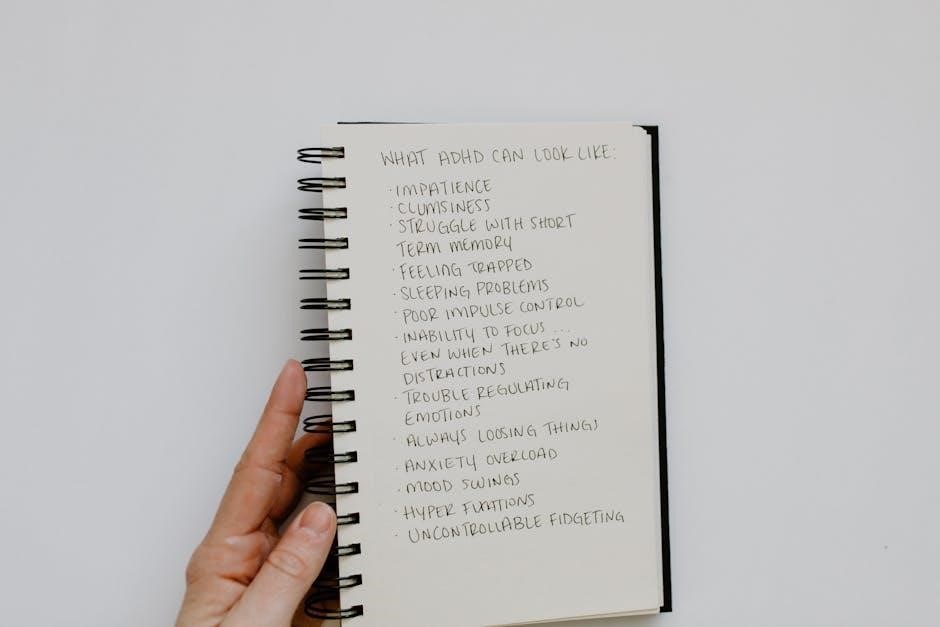Anxiety journaling is a therapeutic practice where individuals record thoughts and emotions to process anxiety. It helps identify triggers, track symptoms, and fosters emotional relief.
1.1 What is Anxiety Journaling?
Anxiety journaling is a therapeutic tool where individuals write down thoughts, emotions, and experiences to manage anxiety. It involves documenting triggers, symptoms, and feelings to gain clarity and perspective. This practice helps identify patterns, reduce stress, and promote self-reflection. By organizing thoughts on paper, individuals can process emotions, develop coping strategies, and track progress over time. It’s a powerful method for self-care and mental health support, fostering mindfulness and emotional relief.
1.2 Benefits of Journaling for Anxiety Relief
Journaling for anxiety offers numerous benefits, including reduced stress, improved emotional clarity, and enhanced self-awareness. It helps identify triggers, process emotions, and develop coping strategies. Regular journaling can lower anxiety symptoms like excessive worry and restlessness. By documenting progress, individuals gain insight into their mental health journey, fostering resilience and long-term well-being. This practice is a simple yet effective tool for managing anxiety and promoting emotional healing.
Therapeutic Journal Prompts for Anxiety
Therapeutic journal prompts for anxiety provide guided questions to explore emotions, identify triggers, and develop coping strategies, aiding in managing and alleviating anxiety effectively.
2.1 Prompts to Identify Anxiety Triggers
These prompts help individuals identify and understand anxiety triggers by reflecting on specific situations, emotions, and physical sensations. Examples include listing anxiety symptoms, describing recent anxiety episodes, and exploring patterns or common themes. By documenting these details, users gain clarity on what sparks their anxiety, enabling targeted strategies for better management and emotional resilience over time.
2.2 Reflective Prompts for Emotional Healing
Reflective prompts encourage deep introspection, helping individuals process emotions and heal from anxiety. Examples include writing about past anxieties, what was learned, and how it strengthened resilience. Users are also guided to reflect on self-compassionate affirmations, mistakes as growth opportunities, and positive affirmations to rebuild self-esteem. These prompts foster emotional release and self-awareness, promoting long-term healing and mental well-being through intentional, meaningful reflection and self-compassion practices.
2.3 Gratitude and Positivity-Focused Prompts
Gratitude and positivity-focused prompts help shift focus from anxiety to joy and appreciation. Examples include writing about things you’re grateful for, what brings happiness, or positive affirmations. These prompts encourage a mindset of abundance, fostering emotional resilience and reducing anxiety by cultivating optimism. Regular practice can enhance mental well-being and help individuals reframe challenges in a more constructive light, fostering a balanced perspective and inner peace.

How to Use a Journal for Managing Anxiety
Using a journal for anxiety involves establishing a routine, reflecting on emotions, identifying triggers, and tracking progress to manage symptoms effectively.
3.1 Creating a Daily Journaling Routine
A daily journaling routine helps manage anxiety by fostering consistency and self-reflection. Dedicate 10-15 minutes each day to write, focusing on prompts that explore emotions, triggers, and gratitude. Start with specific times, like morning or bedtime, to establish a habit. Use printable PDF templates or guided workbooks to stay organized and motivated. Consistency is key to seeing progress and relief from anxiety symptoms over time.
3.2 Tracking Progress and Symptoms Over Time
Regularly documenting anxiety symptoms and emotional states helps identify patterns and measure progress. Use journal templates or trackers to monitor frequency, intensity, and triggers of anxiety episodes. Over time, this data provides insights into what alleviates or exacerbates symptoms, enabling informed decisions for managing anxiety more effectively. Consistent tracking fosters accountability and motivates continued practice, ultimately supporting long-term mental health improvement.

Free Anxiety Journal Prompts PDF Resources
Find free downloadable PDFs with anxiety journal prompts online. These resources offer printable worksheets, trackers, and templates to help manage anxiety and track mental health progress effectively;
4.1 Printable Worksheets for Mental Health
Printable worksheets are essential tools for mental health journaling, offering structured exercises to explore emotions and track progress. Many free PDF resources provide templates for anxiety tracking, mood monitoring, and gratitude practices. These worksheets guide users through reflection, helping to identify triggers and develop coping strategies. They are customizable, making them suitable for both individuals and therapeutic settings. Regular use can enhance self-awareness and emotional well-being.
4.2 Downloadable Templates for Anxiety Tracking
Downloadable templates are invaluable for systematically tracking anxiety symptoms and emotional patterns. Many free PDF resources offer structured formats for mood tracking, symptom logging, and progress monitoring. These templates often include sections for noting triggers, physical sensations, and emotional states, providing a comprehensive view of anxiety episodes. Customizable designs allow users to tailor templates to their needs, making them effective tools for personal or therapeutic use.

Advanced Techniques for Effective Journaling
Advanced techniques like cognitive journaling and grounding exercises offer structured methods to reframe thoughts and manage anxiety effectively.
5.1 Grounding Techniques for Anxiety Reduction
Grounding techniques, such as deep breathing and sensory exercises, help individuals focus on the present. These methods, when incorporated into journaling, allow users to document their experiences, reducing anxiety by promoting mindfulness and emotional stability. Regular practice of these techniques enhances mental clarity, providing a practical tool for managing anxiety effectively.
5.2 Cognitive Journaling for Thought Restructuring
Cognitive journaling involves identifying and challenging negative thoughts, replacing them with positive, realistic ones. By documenting irrational beliefs, individuals can analyze and reframe their perspectives. This process reduces anxiety by fostering rational thinking and emotional resilience. Regular practice helps individuals gain control over their thoughts, leading to improved mental well-being and a reduction in anxiety symptoms.

Case Studies and Success Stories
Case studies reveal how individuals successfully managed anxiety through journaling, sharing inspiring stories of emotional growth and symptom reduction. These testimonials highlight journaling’s practical benefits.
6.1 How Journaling Helped Individuals Overcome Anxiety
Individuals have shared inspiring stories of overcoming anxiety through journaling. By documenting their thoughts and emotions, many have gained clarity and reduced symptoms. Journaling helped them identify triggers, develop coping strategies, and build resilience. These personal accounts highlight the transformative power of journaling in fostering mental well-being and empowering individuals to manage anxiety effectively.
6.2 Real-Life Examples of Journaling Benefits
Real-life examples demonstrate journaling’s profound impact on anxiety relief. Many individuals report reduced stress, improved mood, and enhanced self-awareness; Journaling has helped people reframe negative thoughts, develop gratitude practices, and track progress over time. These tangible benefits highlight how consistent journaling can lead to lasting emotional healing and personal growth, offering a practical tool for managing anxiety effectively.

Mindfulness and Self-Reflection Exercises
Mindfulness journaling combines reflection with grounding techniques, helping individuals stay present and reduce anxiety. It encourages self-awareness, emotional regulation, and inner calm through focused writing practices;
7.1 Mindful Journaling Prompts for Anxiety
Mindful journaling prompts help individuals focus on the present moment, reducing anxiety. Examples include: “Describe your breath right now,” “What sensations do you feel in your body?” or “Write about a calming memory.” These prompts encourage self-reflection, emotional regulation, and inner peace, aiding in anxiety management through intentional, grounded writing practices.
7.2 Self-Soothing Strategies Through Writing
Self-soothing strategies through writing involve techniques to calm the mind and body. Grounding methods, like describing sensory experiences, can reduce anxiety. Deep breathing exercises paired with journaling help focus on the present. Affirmations and gratitude lists also foster emotional balance. Writing about a safe place or listing comforting activities can provide solace. These practices empower individuals to regain control and build resilience against anxiety through intentional, therapeutic writing.

Setting and Achieving Mental Health Goals
Setting mental health goals through journaling enhances clarity and accountability. Tracking progress and celebrating small victories fosters motivation and long-term emotional well-being.
8.1 Goal-Oriented Journaling for Anxiety Management
Goal-oriented journaling is a powerful strategy for managing anxiety by setting clear, actionable objectives. By writing down specific goals, individuals create a roadmap for progress, fostering accountability and motivation. Journaling helps break down larger goals into smaller, manageable steps, making them feel achievable; Tracking milestones and reflecting on successes builds confidence and reinforces positive habits. This approach not only reduces anxiety but also empowers individuals to take control of their mental health journey.
8.2 Celebrating Small Wins in Journal Entries
Celebrating small wins in journal entries is a powerful way to build confidence and reinforce positive habits. By documenting daily achievements, no matter how minor, individuals can track progress and gain motivation. This practice helps shift focus from anxiety to accomplishments, fostering a sense of control and pride. Reflecting on these successes over time can also highlight personal growth and resilience, further enhancing mental well-being and self-esteem.
Anxiety journaling is a proven method for managing anxiety. Regular practice fosters clarity, emotional resilience, and lasting mental well-being. Commit to daily journaling for transformative results.
9.1 The Long-Term Impact of Journaling on Anxiety
Consistent anxiety journaling fosters self-awareness and emotional resilience, reducing anxiety over time. It helps individuals identify patterns, reframe thoughts, and develop coping strategies. Regular practice can lead to long-term mental well-being by promoting mindfulness and self-reflection, ultimately enhancing one’s ability to manage anxiety effectively and maintain a healthier mindset consistently.
9.2 Encouragement for Consistent Practice
Embrace journaling as a lifelong tool for mental well-being. Consistency strengthens self-awareness and stress reduction. Use anxiety journal prompts to guide your reflections, celebrating small victories along the way. Even brief entries can foster clarity and calm. Over time, journaling becomes a trusted companion, empowering you to navigate life’s challenges with resilience and confidence. Make it a habit to nurture your mind and soul regularly.
